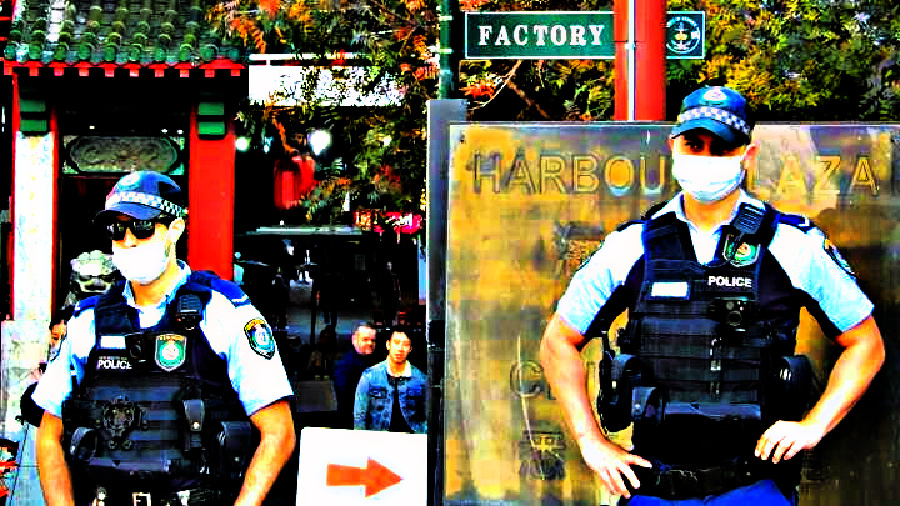BY Paul Gregoire. Sydney Criminal Lawyers Blog.
The measures that were set in place by the Berejiklian government in NSW in response to the outbreak of the Delta strain of COVID-19 were extreme.
Designed to prevent the mass death that was seen elsewhere across the globe, the key approach taken was the lockdown of residents in their homes.
As a means to ensure that stay-at-home orders were followed, the NSW Police Force was positioned as the frontline of the public health response. And this entailed officers monitoring people out on the streets and verifying that they weren’t in breach of public health order rules.
This law enforcement approach saw police issuing steep fines to those found in breach of the ever-changing restrictions and regulations set out in a series of public health orders issued by the NSW health minister under the emergency powers contained in the Public Health Act 2010 (NSW).
According to the Bureau of Crime Statistics and Research (BOCSAR), between the onset of the lockdown on 26 June and 31 August – about six weeks before the stay-at-home orders began being lifted – NSW police detected close to 37,000 COVID breaches.
And in the recent report Breaches of COVID-19 Public Health Orders in NSW, BOCSAR researcher Sara Rahman found that COVID breaches were “largely enforcement-driven rather than reflecting underlying patterns of non-compliance”.
The usual suspects
As the BOCSAR report outlines, there was a spike in COVID cases in southwest Sydney in the initial weeks of the outbreak, and this led to greater police deployment in that area.
The rise in COVID cases in the lower socioeconomic multicultural southwest led to widespread speculation, especially from government, around whether locals weren’t following the orders.
As the cases continued to rise, stricter rules were imposed upon 12 local government areas – then labelled as LGAs of concern – in early August. Eased by 15 September, these harsher measures included a curfew and restrictions on movement outside of one’s own LGA.
The report based its findings on NSW police records and NSW Health COVID infections data. It included a small random selection of police narratives on breaches being detected, as well as responses from 1,028 residents surveyed in the Greater Sydney region.
From 26 June to 31 August this year, NSW police recorded 36,597 COVID breaches. Spikes in the detected breaking of COVID restrictions were found to have occurred in tandem with increases in reported case numbers, as well as when anti-lockdown protests were staged.
The types of breaches recorded were classified into four groups: the breaching of a ministerial direction, the failure to wear a mask, travel-related breaches and other breaches.
Almost 70 percent of recorded breaches involved overstepping a ministerial direction, which mainly meant moving outside of one’s local government area or a travel restriction radius, while close to 30 percent of breaches were in relation to failing to wear a mask.
In terms of how police proceeded against these matters, 88.88 percent resulted in a fine. The typical fine amount issued was $1,000. And almost three-quarters of recorded breaches were males, the majority were in LGAs of concern and close to half were individuals with a prior criminal history.
The BOCSAR analysis also found that the portion of residents who were breaching public health orders was generally low. And overall, this mostly involved low-level breaches, such as not checking in at a shop or not wearing a mask, while more serious noncompliance issues were low.
“We also found somewhat lower rates of noncompliance among people residing in LGAs of concern compared with those residing in other Greater Sydney LGAs,” Rahman notes. “There were only small differences in non-compliant activities across age groups.”
Enforcement-driven
BOCSAR describes the increase in people being proceeded against by NSW police over July and August this year as “dramatic”. And the number of recorded breaches in the second month of this period more than doubled those in the first.
Based on its surveying evidence, the report concludes that the high prevalence of males, those with a criminal record and people in LGAs of concern caught up in having breached COVID restrictions can’t be put down to a simple predilection to break the rules amongst these groups.
Rather, what the data does suggest is an “increase enforcement activity at certain times and locations is the major factor driving breaches”.
In other words, deploying more officers to an area will result in the detection of more breaches, usually of men, who have fallen short of the law in the past.
The results of the BOCSAR study also suggest that the compliance that occurred during the lockdown was more to do with residents choosing to adhere to the measures, rather than any heightened police presence.


